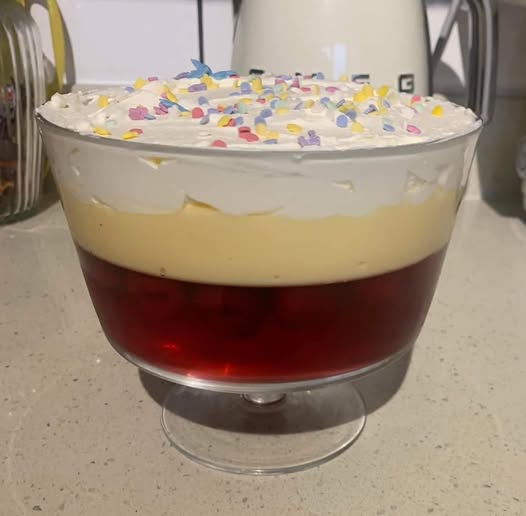Trifle: A Timeless British Dessert of Layers, Luxury, and Loveliness
There are desserts that simply satisfy, and then there are desserts that dazzle. Trifle belongs firmly in the second category—a symphony of textures, colors, and flavors layered into one glorious bowl. From British tea tables to holiday feasts, trifle has long been celebrated as a classic dessert that merges elegance with comfort. Whether you’re tasting it for the first time or grew up with its sweet presence at family gatherings, trifle remains a treat that never fails to impress.
A Brief History: From Humble Origins to Decadent Delight
Trifle has its roots in 16th-century England, where early versions were little more than thickened cream flavored with sugar, rosewater, and spices. Over the centuries, the dessert evolved to include sponge cakes soaked in alcohol, custard, fruit, and whipped cream—layers that define the modern trifle. It was the Victorians, in particular, who turned trifle into an art form, serving it in tall, ornate glass bowls to showcase the beautiful colors and textures.
Today, trifle has taken on countless variations. In some households, it’s a boozy adult indulgence drenched in sherry or Madeira. In others, it’s a family-friendly dish layered with fruit jelly, vanilla custard, sponge fingers, and colorful sprinkles. No matter the version, it captures a certain nostalgic warmth while still offering enough versatility to remain relevant.
The Anatomy of a Classic Trifle
What makes trifle truly special is its layered construction. Each spoonful is a journey, a delightful combination of textures and tastes. A traditional trifle typically consists of the following layers:
-
Base Layer – Sponge Cake or Ladyfingers: Often soaked in fruit juice or alcohol (like sherry), the sponge layer provides the foundation. It’s soft, absorbent, and slightly boozy, giving the dessert a complex depth.
-
Fruit – Fresh or Jelly: Berries are commonly used—strawberries, raspberries, blueberries—sometimes nestled in jelly. The tartness of the fruit balances the richness of the cream and custard.
-
Custard – Velvety and Rich: Thick vanilla custard adds smoothness and body. When homemade, it’s silky and lush, but store-bought custard can work well too.
-
Whipped Cream – Light and Airy: The final flourish, whipped cream crowns the dessert with a cloud-like texture. It can be sweetened slightly or even flavored with a hint of vanilla.
-
Garnishes – Almond Flakes, Grated Chocolate, Sprinkles, or Fresh Fruit: These visual and flavorful enhancements elevate the dessert further.
This harmony of textures is what makes trifle such a satisfying experience—from the soft, soaked sponge to the creamy custard and the cool whipped cream, each element complements the other.
Why Trifle Endures in Modern Kitchens
In an age of highly stylized, Instagrammable desserts, trifle retains a kind of rustic charm. It’s unpretentious, yet visually stunning. It doesn’t rely on delicate piping or intricate baking. Instead, it shines in its simplicity and flavor. More importantly, it’s incredibly customizable.
-
Dietary flexibility: Trifle can easily be made vegan, gluten-free, or sugar-free, with plant-based custards and creams now widely available.
-
Creative freedom: From tiramisu-inspired coffee trifles to chocolate-and-orange creations or tropical mango-coconut versions, the possibilities are endless.
Advertisement -
Make-ahead friendly: Trifles actually benefit from sitting in the fridge overnight, allowing flavors to meld and layers to set beautifully.
This makes it an ideal dessert for holidays, birthdays, or any occasion where you want to impress without overcomplicating things.
A Feast for the Eyes and the Palate
Perhaps what makes trifle so memorable is how it appeals to both the visual senses and the taste buds. Served in a transparent glass bowl or individual cups, its vibrant layers stand proud—ruby red fruit against golden custard, snowy cream, and sponge peeking through.
But trifle isn’t just pretty. It’s deeply satisfying to eat. The way the spoon glides through the layers, the way the custard blends with the whipped cream, and how the soaked sponge melts in your mouth—it all creates a multi-sensory dessert experience.
Personal Reflection: A Dessert That Tells a Story
For many, trifle is more than just a dessert—it’s a memory. It’s grandma in the kitchen whisking custard by hand. It’s Christmas Day, the fridge bursting with leftovers and the trifle bowl sitting regally in the center. It’s kids sneaking spoonfuls while no one is looking. It’s the quiet, content sigh after a long meal, ending with something comforting and cool.
Even when updated for modern tastes, trifle never loses that emotional connection. It reminds us of gatherings, of care, of something lovingly made to share.
Tips for the Perfect Trifle
If you’re planning to make your own, here are a few tips for getting it just right:
-
Choose a sturdy bowl: A clear trifle dish helps show off your work and keeps layers intact.
-
Let the sponge soak: Don’t rush this step. Let the sponge absorb the liquid well—it’ll enhance flavor and moisture.
-
Balance the sweetness: The whipped cream and custard are already sweet. Consider adding tart fruits (like raspberries) or reducing sugar in the sponge to avoid cloying results.
-
Refrigerate overnight: Letting your trifle rest overnight melds flavors and creates better structure.
Final Verdict
Trifle may seem like a simple dessert, but its impact is anything but. It’s a celebration of texture, tradition, and taste. From its historic British roots to its modern variations across the globe, it proves that a good dessert doesn’t need to be complicated—it just needs to be well-loved.
Whether you’re digging into a traditional sherry-soaked version or experimenting with your own twist, trifle is the kind of dessert that brings people together. It’s generous, beautiful, and utterly delicious. And that, in the end, is the mark of a truly great dish.
Rating: 10/10 – A layered legend that continues to charm every generation.




